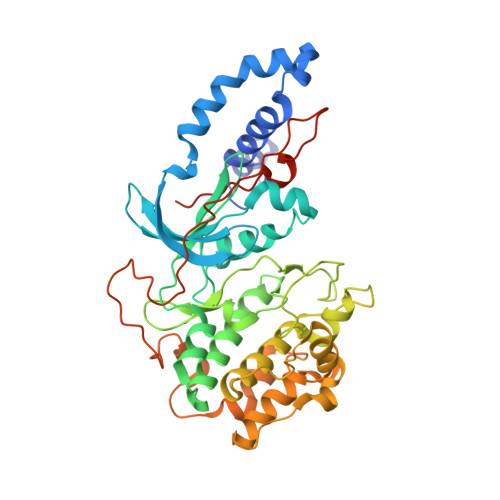RKI-1447 Is a Potent Inhibitor of the Rho-Associated ROCK Kinases with Anti-Invasive and Antitumor Activities in Breast Cancer.
Patel, R.A., Forinash, K.D., Pireddu, R., Sun, Y., Sun, N., Martin, M.P., Schonbrunn, E., Lawrence, N.J., Sebti, S.M.(2012) Cancer Res 72: 5025-5034
- PubMed: 22846914
- DOI: https://doi.org/10.1158/0008-5472.CAN-12-0954
- Primary Citation of Related Structures:
3TWJ - PubMed Abstract:
The Rho-associated kinases ROCK1 and ROCK2 are critical for cancer cell migration and invasion, suggesting they may be useful therapeutic targets. In this study, we describe the discovery and development of RKI-1447, a potent small molecule inhibitor of ROCK1 and ROCK2. Crystal structures of the RKI-1447/ROCK1 complex revealed that RKI-1447 is a Type I kinase inhibitor that binds the ATP binding site through interactions with the hinge region and the DFG motif. RKI-1447 suppressed phosphorylation of the ROCK substrates MLC-2 and MYPT-1 in human cancer cells, but had no effect on the phosphorylation levels of the AKT, MEK, and S6 kinase at concentrations as high as 10 μmol/L. RKI-1447 was also highly selective at inhibiting ROCK-mediated cytoskeleton re-organization (actin stress fiber formation) following LPA stimulation, but does not affect PAK-meditated lamellipodia and filopodia formation following PDGF and Bradykinin stimulation, respectively. RKI-1447 inhibited migration, invasion and anchorage-independent tumor growth of breast cancer cells. In contrast, RKI-1313, a much weaker analog in vitro, had little effect on the phosphorylation levels of ROCK substrates, migration, invasion or anchorage-independent growth. Finally, RKI-1447 was highly effective at inhibiting the outgrowth of mammary tumors in a transgenic mouse model. In summary, our findings establish RKI-1447 as a potent and selective ROCK inhibitor with significant anti-invasive and antitumor activities and offer a preclinical proof-of-concept that justify further examination of RKI-1447 suitability as a potential clinical candidate.
Organizational Affiliation:
Drug Discovery Department, H Lee Moffitt Cancer Center and Research Institute, University of South Florida, Tampa, Florida 33612, USA.
















